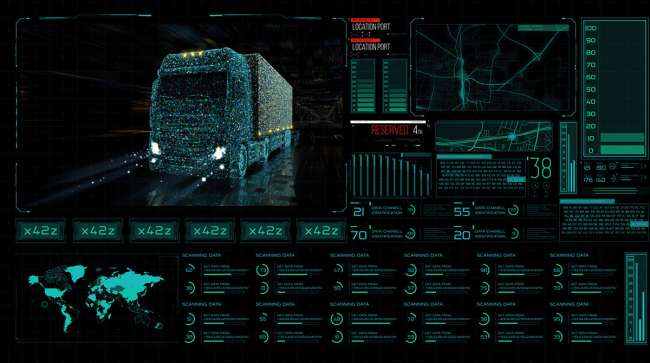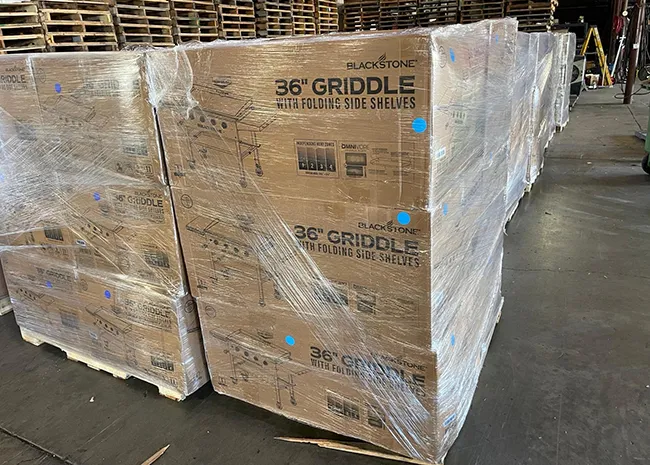Special to Transport Topics
Carriers Feel Insurance Premium Pinch as Cargo Theft Climbs

[Stay on top of transportation news: Get TTNews in your inbox.]
It can be griddles, paint, pharmaceuticals, electronics, cars, vitamins, even sports drinks.
When it comes to cargo theft, thieves can — and do — steal anything. Served up as a crime of opportunity, cargo theft is also a sophisticated, tech-savvy organized crime operation diverting loads and stealing millions of dollars of cargo every year. Often, the cargo disappears without a trace, along with the perpetrators. As more cargo goes missing, insurance premiums for policies to cover the losses start edging higher.
Recovering stolen cargo is possible but rare, noted Jason Odgers, senior vice president for Coral Springs, Fla.-based World Insurance.
“There is some success,” he told Transport Topics, “because whenever these guys steal something, they usually already have some sort of secondary market to go to.”

Odgers
The old Hollywood tropes of stolen goods “falling off the back of a truck” or armed thugs forcing a driver off the road at gunpoint aren’t the current reality. Instead, insurance officials say cargo thieves are finding new, high-tech ways to steal cargo, learning to capitalize on the increasingly digital ways business is conducted.
For instance, thieves can spoof the phone numbers of legitimate freight forwarders; they can hack into carriers’ internal systems and divert cargo; or tap into job boards and assign new, fake destinations for legitimate loads.
Other criminals follow trucks from factories delivering high-value goods for an opportunity to steal merchandise, and in some cases, the vehicle itself. According to the Transportation Intermediaries Association’s State of Fraud in the Industry 2024 Report, cargo theft increased by 600% in six months.
Scott Dickinson, senior broker for the TrueNorth Cos. of Cedar Rapids, Iowa, said the increase in theft is real and growing. While many factors go into insurance rates, criminal actions are playing a part in rate increases being felt across the board.

Dickinson
“On average, rates have risen by 8%-12%, with the extent of the increase largely dependent on an insured’s individual loss history,” he told TT. Companies with long relationships with their insurance carriers, and low claims for loss, are likely to experience lower rate increases, he said.
“However, for those with prior poor loss experiences and increased theft incidents, theft rings often target the same motor carriers or brokers, leading to multiple theft occurrences in quick succession. This can result in much higher rate increases, ranging from 20% to 30% or more,” Dickinson added.
New Methods
Cybercrime and identity theft are playing an ever-increasing role in cargo thefts. Recently, thieves targeted Blackstone Griddles as part of a fictitious pickup scheme. The California Highway Patrol, Golden Gate Division Cargo Theft Interdiction Program described in a press release that the cargo was supposed to travel from Utah to Pennsylvania; however, thieves convinced the carrier the load needed to be rerouted to Sacramento instead.

Recovered Blackstone griddles. (California Highway Patrol)
Lauren Berry, senior vice president and head of Inland Marine at Hudson Insurance Group, explained that in fictitious pickup schemes, computer systems are hacked allowing scammers to call drivers and divert loads, pretending to be legitimate freight forwarders. “The documents are fraudulent or sometimes the trucker is hacked, and the information is stolen,” she said. “So much of it is electronic and done on the internet, whereas 15 years ago you would never see that.”
Tammy Kozelek, claims manager for Stevens Point, Wis.-based Sentry Insurance, said sometimes, theft can be stopped with a simple phone call.
“We recently were talking to an insured that the broker called them and said, ‘Hey, we screwed up, it’s supposed to be delivered (somewhere else).’ And the truck driver did it.”
The load was taken to the new location, unloaded by “agents” who were expecting it, and it was only later the trucking company discovered they’d delivered the cargo to scammers.
Kozelek said high-tech crime can be stopped by relatively low-tech solutions. She recommends starting with a nationwide background check, and continuing through making sure internet security at the office is up to date. It continues through simple follow-ups.
“Had they just stopped and said, let me call you back, and then actually called the broker back then, they would’ve found out that the telephone number had been spoofed,” she said.
While theft tends to be concentrated in port regions on the coast, it’s not exclusive to those areas.
Tim Horgan, chief marketing officer with Hub International’s transportation practice, told TT, “It’s countrywide. it could be in Dubuque, Iowa, or Miami,” he said.
McLeod Software CEO Tom McLeod explores the potential for artificial intelligence to boost efficiency and build resilience. Tune in above or by going to RoadSigns.ttnews.com.
Government case files show the crimes are widespread. The FBI recently detailed the successful prosecution and prison sentences for a criminal gang that was preying on high-value cargoes in the southeastern U.S. While the stolen goods were bound for black markets in Florida, the thefts themselves occurred all over the region. The federal government identified computers stolen from Emerson and Macon, Ga.; copper lifted from rural Denmark, Tenn.; and clothing hijacked from small-town Kingsland, Ga.
Understanding Policy
Odgers explained that cargo insurance policies come in two parts. First, the carriers themselves carry insurance on their loads; and then shippers can — and are recommended to — purchase Shipper’s Interest policies.
The problem is, Odgers said, many people don’t understand why they need to purchase their own insurance policies for products being shipped; many don’t know exactly what they’re insured for, or how the policies work. Thefts might be covered, or they might not, depending on the load, how it was stolen and the coverage purchased in advance.
While theft rates drive up policy rates, he said, the increases aren’t making up for the amounts being stolen.
Odgers said some insurance carriers have taken numerous steps to limit risk. Policies won’t cover theft if loads are left unattended, or require guarded, secure yards with electronic surveillance if loads must be parked overnight. Some policies require GPS tracking on trailers. Still others dictate which routes can be taken, and others refuse to cover some high-target loads — such as automobiles, pharmaceuticals or electronics — altogether.
“That’s a particular problem for, especially for the truckers, who may not necessarily be experts in their policy,” Horgan said, noting many people don’t read their policy.

Berry
Berry said she doesn’t think excluding entire classifications of products is the best way to mitigate risk for the insured — or the insurance companies.
She pointed out that many trucking companies don’t specialize in one particular type of cargo; a driver could start out with household cleaning items, then pick up a load of electronics for the next stage.
“You want to bond with the customer. You want to look at their practices, you want to help them with that verification and tracking. Just isolating and cutting it off isn’t the answer,” she said.
Horgan said rates can depend on commodity, geography but especially on the experience of the drivers and the carriers.
“There’s a direct relationship between thefts, losses and your premiums. Your thefts go down, your premiums go down; that’s pretty clear,” Horgan told TT.
Brad Schneider, director of underwriting for Sentry, said his company looks at the commodities being hauled, the experiences of the companies and the qualities of the drivers before writing a policy.
“We have to have a comfort level in order to offer those limits,” he said, adding that his firm doesn’t set limits based solely on commodity, but limiting exposure is important.
Nick Saeger, associate vice president for pricing and products at Sentry, said his company also might look to put higher deductibles on commonly stolen commodities.
“Now the insured has skin in the game too,” Saeger said. “Having those higher deductibles … makes them think a little bit more about their safety practices as well.”
Horgan said good insurance carriers, in addition to writing the policies, have policies that cover all possible exposures and have strong claims operations and fraud investigation arms that can help recover stolen loads.
Stopping Cargo Theft
More important than investigating the theft in the first place, experts agree, is preventing it in the first place.
Berry recommends companywide training to ensure employees recognize how to tell the difference between legit and scam freight brokers or carriers, and to understand how everyone, from the top down, can help prevent cargo theft.
“Verification and the tracking, those two things, verification and tracking. If the company doesn’t have a good plan to do those two things, there’s going to be a problem,” she said.
That includes hiring good drivers and investing in ongoing training to make sure employees are aware of the latest swindles.
Tracking can include cameras, GPS, RF or cellular trackers. Any of these tools can help authorities find — and recover — a stolen load.
Schneider said tracking devices and cameras don’t prevent theft, but they do help recover the cargo and bring thieves to justice.
“GPS tracking devices on trailers are a good starting point. It may not prevent the theft, but it certainly helps track down a stolen trailer, which may minimize the final loss cost.”

Kozelek
Just as important is having a good relationship with authorities, Kozelek said.
The California Highway Patrol said at least two crimes were solved thanks to strong relationships between authorities and private companies. CHP said the stolen Blackstone griddles were recovered with the help of tracking by private industry. In another example, CHP said relationships built with private industry were directly responsible for the recovery of $229,000 in stolen Sherwin-Williams paint hijacked from Nevada. The paint was eventually tracked to, and recovered in, Stockton, Calif.
However, most loads are not recovered. The industry average for recovery, Odgers said, is between 8% and 12%. In the federal case, the FBI accused the theft ring of stealing at least $1.7 million in cargo, not counting the trucks or trailers. None of it was ever found.
An Unbalanced Field
Insurers agree that this will help drive up policy costs — and the pain of higher cargo insurance costs will be felt disproportionately by smaller firms.
Want more news? Listen to today's daily briefing above or go here for more info
“If we and if law enforcement can’t recover, and can’t decrease the number of thefts, all that really means is the actuaries and the underwriters are going to find that and charge higher rates,” Saeger said.
“A small carrier, you know, pays a couple thousand dollars for cargo insurance, but has a total loss of a hundred thousand dollars — it’s going be a long time before that small carrier can ever be profitable again in cargo,” Horgan said.
Dickinson concurred.
“Smaller and less experienced carriers may struggle to afford comprehensive theft coverage,” he said. “Without economies of scale, a single theft loss can have a profound impact on their rates. … As a result, we’re seeing a trend toward higher deductibles for all motor carriers and freight brokers. Unfortunately, smaller carriers are often less equipped to absorb higher deductibles, or the investments required to improve cargo security and prevent future theft incidents.”





